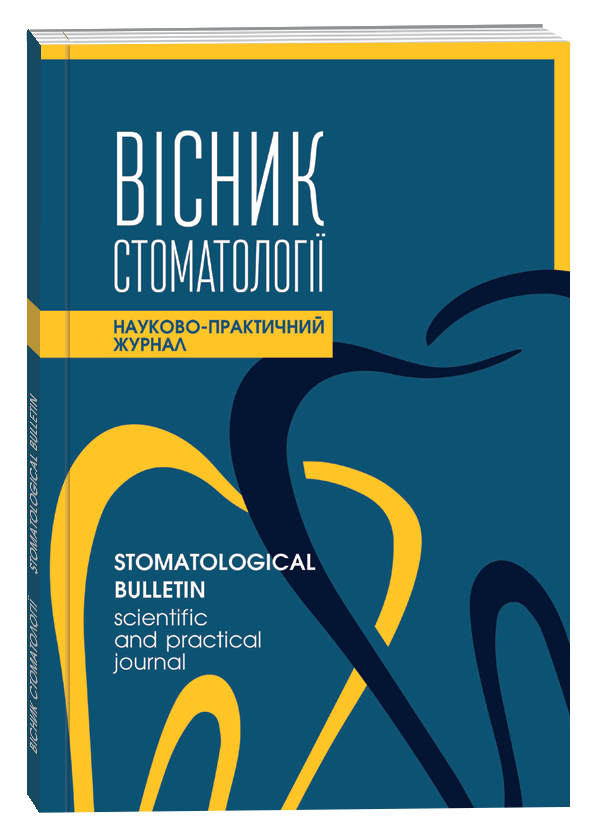ANALYSIS OF CLINICAL AND PATHOGISTOLOGICAL DIAGNOSES OF PATIENTS WITH NEOPLASMS OF THE SALIVARY GLANDS ACCORDING TO THE ARCHIVAL HISTORIES OF PATIENTS IN THE CLINIC OF THE O.O. BOGOMOLETS NMU IN THE PERIOD 2014-2018 YEARS
Keywords:
neoplasms of the salivary glands, pleomorphic ade-noma, adenolymphoma, adenocarcinoma, clinical morphologi-cal evaluationAbstract
The prevalence of tumors of the salivary glands are still high – from 3 to 6 % of all tumors of the head and neck. The most common benign tumor is a pleomorphic adenoma, ranging from 58 to 92 %, and among malignant tumors - mucoepidermoid ad-enocarcinoma – 20-34 %. Most of the tumors of the salivary glands in the early stages have a typical non-expressed clinical features, which leads to late appearances of patients to the doc-tor. Despite of significant advances in surgical treatment, im-provement of diagnostic methods, divergence between clinical and pathogistological diagnosis remain rather high – 30-40 % . Therefore the purpose of the study is to carry out the analysis of archival materials of patients with neoplasms of the salivary glands according to the clinical and pathogistological diagnoses that were treated on the basis of the clinic of the O.O. Bogomolets in the period 2014-2018 years. The material exami-nation was archival histories of 232 patients with neoplasms of the salivary glands. The average age of patients was 52±14.5 g. Women constituted 144 (62.06%), men 88 (37,09 %). All pa-tients were examined (blood tests, ECG, CT, MRI, ultrasound, etc.). Performed typical surgical interventions - excisional biop-sy, partial, subtotal, total parotidectomy. Postoperative material was subject to pathogistological study. The analysis of archive histories of diseases with neoplasms of the salivary glands has shown that in 97 (41.81 %) patients, there was no coincidence of clinical and pathogistological diagnoses. At the same time, in the two groups, this percentage was the largest (pleomorphic adenoma – adenocarcinoma) – 36 (37.11 %) and the group (pleomorphic adenoma – adenolymphoma) – 23 (23.71 %). Among the malignant neoplasms of the salivary glands, the largest number of patients had mucoepidermoid cancer and acinar-cellular adenocarcinoma – 16 (34, 78 %) and 12 (26, 08 %) patients, respectively.
References
El-Naggar A.K., Chan J.K.C., Grandis J.R., Takata T., Slootweg P.J. WHO Classification of Head and Neck Tumours. Lyon: IARC Press, 4th edition, Volume 9, 2017:159-202.
Tian Z., Li L., Wang L., Hu Y., Li J. Salivary gland neoplasms in oral and maxillofacial regions: a 23-year retrospective study of 6982 cases in an eastern Chinese population. Int J Oral Maxillofac Surg. 2010;39:235-242.
Lyu H.X., Wang Z.R., Gao Y.Q., Yu M., Li B.Q., Zhang Z.B. Clinical pathologic analysis on 3 724 cases of salivary gland tumors. Zhonghua Kou Qiang Yi Xue Za Zhi. 2019 Jan 9;54(1):10-16.
Spiro R.H. Salivary neoplasms: overview of a 35-year experience with 2,807 patients. Head Neck Surg. [Internet]. cited 2017 Jul 9];8(3):177–184.
Wang X-d, Meng L-j, Hou T-t, et al. Tumours of the salivary glands in northeastern China: a retrospective study of 2508 patients. Br J Oral Maxillofac Surg. 2015;53:132–137.
Gazal' A. S., Izatulin V. G., Leven I. I. i dr Morphological substantiation of improvement of puncture of the parotid salivary glands. Sibirskij medicinskij zhurnal — Irkutsk.2007;5:17-20.
Sotelo-Gavito J.J., Pérez-Montaño M., Alderete-Vázquez G., Capetillo-Hernández G., Grube-Pagola P. Salivary gland tumors in Veracruz. Experience of two institutions. Rev Med Inst Mex Seguro Soc. 2018 Mar-Apr;56(2):148-153.
Da Silva L. P., Serpa M. S., Viveiros S. K., Sena D. A. C., de Carvalho Pinho R. F., de Abreu Guimarães L. D., de Souza L. B. Salivary gland tumors in a Brazilian population: a 20-year retrospective and multicentric study of 2292 cases. Journal of Cranio-Maxillofacial Surgery. Volume 46, Issue 12, December 2018, Pages 2227-2233.









